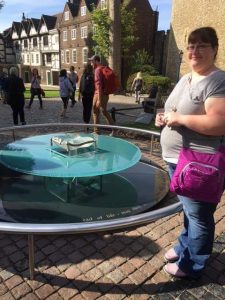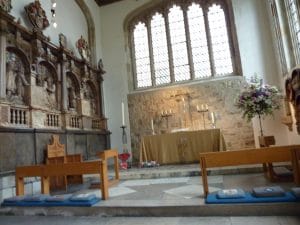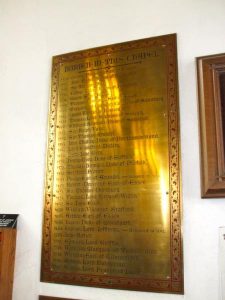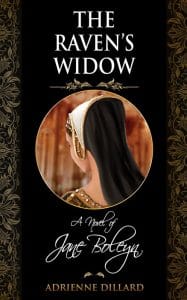 To commemorate the anniversary of the execution of Jane Boleyn, Lady Rochford, along with Queen Catherine Howard, and to celebrate the release of her latest novel, The Raven’s Widow: A Novel of Jane Boleyn, we have a guest article from the lovely Adrienne Dillard today. Welcome to the Anne Boleyn Files, Adrienne, it’s a real honour to have you here!
To commemorate the anniversary of the execution of Jane Boleyn, Lady Rochford, along with Queen Catherine Howard, and to celebrate the release of her latest novel, The Raven’s Widow: A Novel of Jane Boleyn, we have a guest article from the lovely Adrienne Dillard today. Welcome to the Anne Boleyn Files, Adrienne, it’s a real honour to have you here!
When I wrote my first novel, Cor Rotto: A Novel of Catherine Carey, I felt like I had a bit of a disadvantage. Though I could read any number of first-hand descriptions of the locations where my story took place; nothing could come close to experiencing it first-hand. Sure there were plenty of photographs available to me, but those only told half of the story. I needed to stand in those places to get a true sense of them. What did they smell like? What was the view like? Could I hear the rushing of the Thames or just see it? Was the room cosy and bright or chilly and damp? As I wrote that first novel, I had to trust my instincts and make scientific guesses, but with my second one, I wanted everything to be just right.
During the last week of September 2016, my dream to place my own feet in the footsteps of Jane Boleyn, Lady Rochford, finally came true. I set off from my home in the Pacific Northwest, USA, bright and early on a Thursday morning and by Saturday I was walking through the alabaster walls of that mighty fortress, the Tower of London. I really had no idea what to expect as I ambled past the ticket booths, snaking my way through the throng of tourists, but I knew without a doubt that I was in for a treat. I should also mention that I was accompanied on this first visit to the Tower with a group of wonderful authors and historians from MadeGlobal Publishing! Not only did I get to see these amazing sights first-hand, but I also had a bounty of historical knowledge right there at my fingertips. You haven’t lived until you’ve seen the place where Anne Boleyn was executed with the Queen of Anne Boleyn knowledge, Claire Ridgway, herself! I kept pinching myself to make sure I wasn’t dreaming.
There was so much to see and experience at the Tower; I ended up returning for one last visit at the end of the week just before I headed back home. I could go on and on about all the fascinating things I saw during those two days at the place where Jane Boleyn spent her last days, but I’m going to narrow it down to the one thing that left the most lasting impression.
The Chapel of St. Peter ad Vincula and the Scaffold Memorial

As I stared down at the glass pillow and the table surrounding it, I felt a catch in my throat. It took a moment for the gravity of it all to settle upon me, but when it did, I had to blink back the tears pricking behind my eyes. There are several names on the memorial, but only three of them held my gaze: Queen Anne Boleyn, Queen Katherine Howard and Jane Boleyn, Viscountess Rochford.
“It takes your breath away, doesn’t it?”
I turned to see my companion, Beth von Staats, of Queen Anne Boleyn Historical Writers (queenanneboleyn.com), fighting back her own tears. We stood together quietly, admiring the artist’s handiwork while contemplating the tragedies he sought to honour.
Before too long, the warder’s spiel was finished and we were finally allowed to shuffle into the chapel where all three women had been laid to rest. My anticipation was so great that I found it hard to breathe as I descended the few steps leading into the entrance. Knowing I would write a scene that would take place in this very room, I wanted to soak in all I could. I was terrified that something would slip my notice. I took my time walking down the aisle, my eyes drinking in the beauty of my surroundings. I found no pews, only simple wooden chairs, so I took the first one in the front row, nearest to the chancel. You can’t approach the graves of the executed, so I had to make do. Turns out that I had great taste because, on my second visit to the chapel later that week, the warder told us all that Her Majesty, Queen Elizabeth II, sat in the very same chair on her last visit to the chapel. Colour me chuffed!
The warder strode confidently up to the front once we had all taken our seats and planted his feet next to the pillar a few paces to my left. From his perch, he launched into the stories of the men and women who found themselves on the business end of the axe (or sword). I heard the words he was saying, but I must admit that I wasn’t truly listening. I was so fixated on my surroundings’ I had tuned him out. Somehow the words, “And just below me, right underneath this pillar is where they say George Boleyn was buried,” managed to filter through my subconscious. My body literally jolted to attention. That name, George Boleyn, seemed to cut right through me and steal my breath. Later, as we filed out of the chapel, Sarah Bryson, biographer of both Mary Boleyn and Charles Brandon, whispered to me, “I saw you jump when they said George’s name!”
I found out later that what the warder said about George’s grave was wrong. The best guesses actually place him much deeper into the chapel, closer to his sister. But the effect of his words remained. For a few brief moments, I was standing in the same space occupied by the earthly remains of people I had I studied and loved for so long.
The tour was wrapped up all too quickly and before long we were being hustled out of the chapel. I dawdled for as long as I could and then paused one last time just inside the doorway to read the metal plaque gracing the wall. Underneath the ornate heading “Buried in This Chapel” is a list. I found George Boleyn and Queen Anne Boleyn at the top next to the year 1536, but when I searched down the list to the year 1542, I saw that it went to 1549 just after Queen Katherine Howard’s name.

“Oh she wasn’t considered notable enough to be listed,” he replied with a dismissive wave.
My heart fell. How could Jane not be notable enough to make the list? Katherine Howard may have been the second queen to be executed, but Jane was the first maid to follow her mistress to the scaffold. She came from a good family with strong ties to the nobility and served all, but one of the king’s wives. The eighth Henry changed the laws of the kingdom to execute her for goodness sake! From that moment on, no one was safe, regardless of their mental stability.
The warder’s words reminded me of why I set out to write The Raven’s Widow in the first place, and noting the absence of George’s name on the Tower Hill scaffold memorial a few hours later as we walked back to the tube station hammered the point home. Over time, the truth of their lives has been distorted; their reputations maligned. Their voices have been stolen, but maybe it’s not too late. We can find them again if we look hard enough.
 Adrienne Dillard, is a graduate with a Bachelor of Arts in Liberal Studies with emphasis in History from Montana State University-Northern. She has been an eager student of history for most of her life and has completed in-depth research on the American Revolutionary War time period in American History and the history and sinking of the Titanic. Her senior university capstone paper was on the discrepancies in passenger lists on the ill-fated liner and Adrienne was able to work with Philip Hind of Encyclopedia Titanica for much of her research on that subject. Her previous works include best-selling novel,“Cor Rotto: A Novel of Catherine Carey” and “Catherine Carey in a Nutshell” for MadeGlobal’s History in a Nutshell series. Her newest novel, The Raven’s Widow was released in February 2017. When she isn’t writing, Adrienne works as an administrative assistant in the financial services industry and enjoys spending time with her husband, Kyle, and son, Logan, at their home in the Pacific Northwest.
Adrienne Dillard, is a graduate with a Bachelor of Arts in Liberal Studies with emphasis in History from Montana State University-Northern. She has been an eager student of history for most of her life and has completed in-depth research on the American Revolutionary War time period in American History and the history and sinking of the Titanic. Her senior university capstone paper was on the discrepancies in passenger lists on the ill-fated liner and Adrienne was able to work with Philip Hind of Encyclopedia Titanica for much of her research on that subject. Her previous works include best-selling novel,“Cor Rotto: A Novel of Catherine Carey” and “Catherine Carey in a Nutshell” for MadeGlobal’s History in a Nutshell series. Her newest novel, The Raven’s Widow was released in February 2017. When she isn’t writing, Adrienne works as an administrative assistant in the financial services industry and enjoys spending time with her husband, Kyle, and son, Logan, at their home in the Pacific Northwest.
More about The Raven’s Widow: A Novel of Jane Boleyn…
The river was as calm as I had ever seen it. Ordinarily, the tide would have been wild by this time of year, and woe unto any man unfortunate enough to fall into the fierce currents of the Thames. Tonight the tides were still, and the surface of the water appeared glassy. When I peered down into the dark depths, I saw my tired, drawn face wavering in the reflection. I quickly turned away as I fought back a wave of nausea, frightened by the anguish I saw etched there.
“Only a few moments more my lady, the Tower is just ahead.”
————–
 Jane Parker never dreamed that her marriage into the Boleyn family would raise her star to such dizzying heights. Before long, she finds herself as trusted servant and confidante to her sister-in-law, Anne Boleyn; King Henry VIII’s second queen. On a gorgeous spring day, that golden era is cut short by the swing of a sword. Jane is unmoored by the tragic death of her husband, George, and her loss sets her on a reckless path that leads to her own imprisonment in the Tower of London. Surrounded by the remnants of her former life, Jane must come to terms with her actions. In the Tower, she will face up to who she really is and how everything went so wrong.
Jane Parker never dreamed that her marriage into the Boleyn family would raise her star to such dizzying heights. Before long, she finds herself as trusted servant and confidante to her sister-in-law, Anne Boleyn; King Henry VIII’s second queen. On a gorgeous spring day, that golden era is cut short by the swing of a sword. Jane is unmoored by the tragic death of her husband, George, and her loss sets her on a reckless path that leads to her own imprisonment in the Tower of London. Surrounded by the remnants of her former life, Jane must come to terms with her actions. In the Tower, she will face up to who she really is and how everything went so wrong.
“Jane Boleyn is finally given the thoughtful and poignant story she has long been denied” – Olga Hughes, Nerdalicious.com.au
“An absorbing story that draws you into a vividly created world” – Amy Licence, Best-Selling Author and Historian
The Raven’s Widow: A Novel of Anne Boleyn is available as a kindle book and paperback and you can find out more about it on your country’s Amazon store by going to http://getbook.at/ravenswidow
Paperback: 378 pages
Publisher: MadeGlobal Publishing (February 2017)
Language: English
ISBN-10: 8494649833
ISBN-13: 978-8494649837
Kindle ASIN: B01NB1FMCE
Pictures: Photo of Adrienne Dillard at the memorial c. Adrienne Dillard; Photo of interior of the Chapel of St Peter ad Vincula and burial list c. Paudie Kennelly.